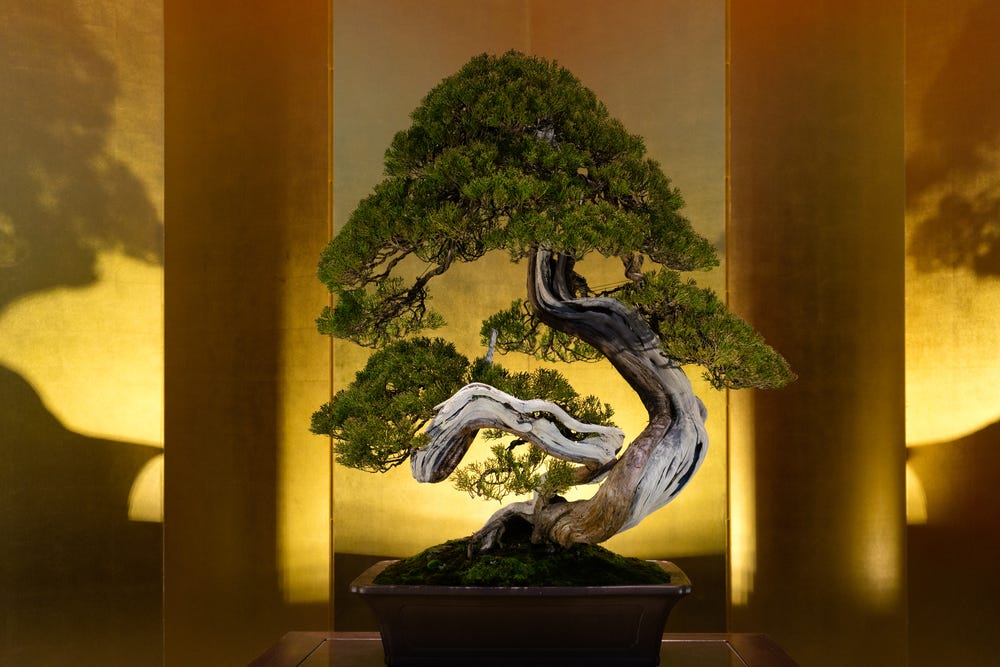Investing Lessons From Hunting For Bonsai Treasure
I paused. All three trees looked so tempting. Why not buy them right now, my mind urged?
I paused. All three trees looked so tempting. Why not buy them right now, my mind urged?
I am part of a group of slightly crazy people who are into the art of bonsai as a hobby. In Japanese “bon” means “container” and “sai” means “tree,” so bonsai is literally translated as “container tree.” In practice, the goal isn’t to just stick any tree in any container, but to come up with a great match between a tree and a ceramic pot to create an illusion of a giant tree in miniature.
The Spring Bonsai Hunt
Every Spring, I go on a treasure hunt at local (and sometimes not-so-local) tree nurseries to find suitable specimen to turn into Bonsai. While in theory any tree could be made into a Bonsai, some are much better suited than others.
When I started around 5 years ago, my instructor was emphatic – you want to only purchase trees that combine all the desired characteristics, not just one. Otherwise, he warned me, I will end up with a lot of mediocre material that I will later regret.
That means that we are looking for trees that have an interesting trunk line, good surface roots, compact foliage and some interesting features. That’s pretty rare. You can go through a nursery with hundreds of trees and not find a single one that has all of those boxes checked.
When I started out, I didn’t listen. As soon as I found a tree that had any one of the desired parameters I convinced myself that it was “the one” and promptly bought it. Sure enough, over the subsequent couple of years I ended up with a lot of trees that were far from special.
What’s the big deal? Well, there is a big cost to having mediocre trees. They still require space. More importantly, they require time. So the opportunity cost of filling your yard with mediocre trees is foregoing the chance to work on the really good ones and saving the resources for those.
There is a twist to the nursery stock treasure hunt. The hobby of bonsai goes into hibernation from late Fall until Spring. There isn’t much to do in between, and when I visit that first tree nursery in the Spring I am pretty eager to get my hands on something new to work on.
Which brings me back to last week. This was my first nursery visit after months of abstinence. The three trees could definitely be turned into bonsai. It was very tempting.
But something was wrong. Deep down I knew they weren’t all “the ones.”
The Checklist and Regret Minimization
Over the years, I developed a gut-check rule on whether a tree was special enough to buy. If when I first inspected the tree I immediately felt like putting it into the cart to prevent it from being taken by others, it was likely “the one.” If, on the other hand, I had to think about whether it was good enough, then clearly it wasn’t.
Looking at the three trees, I decided I needed some perspective. It was my first nursery of the year, and I was probably heavily biased towards getting new trees. I decided to take a hike around the nearby Walden Pond and reflect on my checklist for how I wanted to expand my collection this year.
During my walk, my tree-lust subsided. I reminded myself of my instructor’s criteria. I also considered my own goals based on my needs and circumstances: smaller trees (my back isn’t getting any younger), new species or those I identified as part of a small list of desired ones.
When I returned and examined the trees, everything became clear. One, a dwarf Japanese Holly, I immediately put into a cart. The other two I spent some time examining and asked myself: how upset would I be if I were to leave, then later decided to come back for them and they were gone?
My answer was not very. That told me everything that I needed to know. On that first day of hunting for bonsai treasure having visited 3 tree nurseries, I bought only a single small tree.
How is all of this related to investing? Warren Buffett, in his recent Berkshire Hathaway annual letter wrote that Berkshire’ whole 60-year record is mostly driven by a dozen investments. The rest largely netted out to not much in terms of profits. That’s about one investment every 5 years!
How many of us are willing to wait a year without making a new investment, much less five? I would wager not many. The temptation to act is simply too great for most.
So here are some lessons from my 20+ years of investing and my 5+ years of bonsai practice to help you hunt for new investment opportunities:
Really good investment opportunities are exceedingly rare most of the time. If you find yourself easily finding great investments in most market environments, chances are your criteria are way too loose… or you are way better than Warren Buffett.
You need to have a checklist for what makes a great investment. That checklist needs to have specific criteria that you could measure any opportunity against. It also needs to specify the minimum combination of criteria that you will require to proceed.
You should understand your circle of competence really well and know which “species” of investments fit your approach.
Once you have some experience, when you spot a great investment you should feel like dropping everything you are working on and investigating it immediately.
You should think about investment opportunities through the lens of regret minimization. If you don’t do work on this investment right away and it drastically increases in price, how upset will you be?
If you liked this article, please “like” and share this article.
About the author
Gary Mishuris, CFA is the Managing Partner and Chief Investment Officer of Silver Ring Value Partners, an investment firm that seeks to apply its intrinsic value approach to safely compound capital over the long-term. He also teaches the Value Investing Seminar at the F.W. Olin Graduate School of Business.




Great analogy Gary. Thank you for sharing.
Retail investor here. Thanks for the reminder, can’t hear that message to often. The market is not going away, there will always be another opportunity to trade. I just need to be there with money in my pocket . Current short rates sure help with that. BTW, i’m confused on the size of tree you start with, any chance, you show us a picture of your recent selection? Thanks again for your posts.